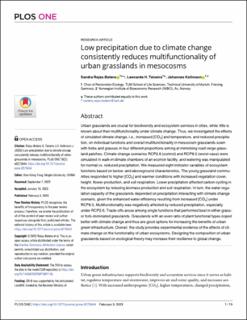| dc.contributor.author | Rojas-Botero, Sandra | |
| dc.contributor.author | Teixeira, Leonardo H. | |
| dc.contributor.author | Kollmann, Johannes | |
| dc.date.accessioned | 2023-09-27T12:03:22Z | |
| dc.date.available | 2023-09-27T12:03:22Z | |
| dc.date.created | 2023-02-26T15:05:55Z | |
| dc.date.issued | 2023-02-03 | |
| dc.identifier.citation | PLOS ONE. 2023, 18 (2), 1-19. | en_US |
| dc.identifier.issn | 1932-6203 | |
| dc.identifier.uri | https://hdl.handle.net/11250/3092406 | |
| dc.description.abstract | Urban grasslands are crucial for biodiversity and ecosystem services in cities, while little is known about their multifunctionality under climate change. Thus, we investigated the effects of simulated climate change, i.e., increased [CO2] and temperature, and reduced precipitation, on individual functions and overall multifunctionality in mesocosm grasslands sown with forbs and grasses in four different proportions aiming at mimicking road verge grassland patches. Climate change scenarios RCP2.6 (control) and RCP8.5 (worst-case) were simulated in walk-in climate chambers of an ecotron facility, and watering was manipulated for normal vs. reduced precipitation. We measured eight indicator variables of ecosystem functions based on below- and aboveground characteristics. The young grassland communities responded to higher [CO2] and warmer conditions with increased vegetation cover, height, flower production, and soil respiration. Lower precipitation affected carbon cycling in the ecosystem by reducing biomass production and soil respiration. In turn, the water regulation capacity of the grasslands depended on precipitation interacting with climate change scenario, given the enhanced water efficiency resulting from increased [CO2] under RCP8.5. Multifunctionality was negatively affected by reduced precipitation, especially under RCP2.6. Trade-offs arose among single functions that performed best in either grass- or forb-dominated grasslands. Grasslands with an even ratio of plant functional types coped better with climate change and thus are good options for increasing the benefits of urban green infrastructure. Overall, the study provides experimental evidence of the effects of climate change on the functionality of urban ecosystems. Designing the composition of urban grasslands based on ecological theory may increase their resilience to global change. | en_US |
| dc.language.iso | eng | en_US |
| dc.publisher | PLOS | en_US |
| dc.rights | Navngivelse 4.0 Internasjonal | * |
| dc.rights.uri | http://creativecommons.org/licenses/by/4.0/deed.no | * |
| dc.title | Low precipitation due to climate change consistently reduces multifunctionality of urban grasslands in mesocosms | en_US |
| dc.title.alternative | Low precipitation due to climate change consistently reduces multifunctionality of urban grasslands in mesocosms | en_US |
| dc.type | Peer reviewed | en_US |
| dc.type | Journal article | en_US |
| dc.description.version | publishedVersion | en_US |
| dc.rights.holder | © 2023 Rojas-Botero et al. | en_US |
| dc.source.pagenumber | 1-19 | en_US |
| dc.source.volume | 18 | en_US |
| dc.source.journal | PLOS ONE | en_US |
| dc.source.issue | 2 | en_US |
| dc.identifier.doi | 10.1371/journal.pone.0275044 | |
| dc.identifier.cristin | 2129344 | |
| dc.source.articlenumber | e0275044 | en_US |
| cristin.ispublished | true | |
| cristin.fulltext | original | |
| cristin.qualitycode | 1 | |

